








DIRECTION: BROOKE PAN / FRANCES BOBBIT WRITING: RITA WANG

MAKEUP: NATALIE DINH
PHOTOGRAPHY: BEN LEVINE
MODELLING: CHRIS YANG / YASMIN MCLAMB / CLAIRE PAVLIDES LAYOUT: RUBY GRANT STYLING: SEO-EUN KIM / AMELIA WANG

















DIRECTION: BROOKE PAN / FRANCES BOBBIT WRITING: RITA WANG

MAKEUP: NATALIE DINH
PHOTOGRAPHY: BEN LEVINE
MODELLING: CHRIS YANG / YASMIN MCLAMB / CLAIRE PAVLIDES LAYOUT: RUBY GRANT STYLING: SEO-EUN KIM / AMELIA WANG







Swirling twirling twisting trails of jewels, from the ground up, filling up with a blooming overwhelming sense of warmth. Biting into it is the most evoking longing feeling of pooling delight, lingering, washing out everything else. There’s nothing quite like it, truly. Your lightness caramelizes into solid gold, pure and concentrated. It’s pleasant. It’s bright. It’s thick delightful happiness. The joys are elevated---your pride becomes aromatic honeyed glazed and your courage a savory pickled crunch.









One bite can make you realize you have lived your life without a tradition, a taste, so prominent. Amour propre becomes delicious amuse-bouche. Gratitude expressed with citrus. Sadness turns tangy.




Like a touch of pure gold, it wraps and transforms you, all the parts of you, into value. Fog smokes you; clouds of steam coat you. Don’t cry--- your tears are delicate soups in snowy storms. Don’t scream--- your shouts are sharp stings from steamed fish bones during new years. I love you is counted in plates and bowls. Culture passed from touch to touch, bite to bite. How can you not be changed? Like every treasure, thieves are at large. They take the magic and attempt to suppress it, warp it. Gold dulls into imitation, and the shine becomes an aged hue. They try to villainize us, taking advantage of our gentle tender exterior. Assurance whisked into bitter hatred. Patience fried into oily distrust.

Love pressed into sour obsession. They are not satisfied, they never will be. They think your gold is a facade, a flaky garnish resting on top of a treasure they can steal. They believe your disposition is easy to crack, like a porcelain-white egg. But your gold is pure, your gold is whole. Once touched, your gold blooms inside out. Like the egg, your insides are golden, never let them forget. MSG is not an additional step, it is essential. Your anger, anxiety, honesty, loyalty, pride, jealousy, happiness make up a family size banquet feast. Each plate is different but delightfully delicious concoctions connected by gold. Never let them forget how, with msg, you can simmer, scramble, saute, steam to brilliant perfection.
YOUR IS PURE, YOUR IS WHOLE



Direction: McKale Thompson
Photography: Jessie Goodwin & Alex Nickel
Modeling: Yagazie Aguwa, Simi Olabode, Maame Adu, Aries Ballard, Habi
Doumbouya, Abby Sode, Leslie Sackey, Bria Armani Couliboly, Maame Darkwah, Joyce Djikeng, Helen Telahun & Erika Yanou
Layout: Ruby Grant
Styling: Robin Pyo & Eyit Bada
Writing: Hieran Andeberhan & Simi Olabode
Makeup: Caroline Bixby & Olivia Slemmer


metropolitan city in North West Africa,
a group of eager visitors gather to embark on a tour guided by a native griot,a traditional sto- ryteller and historian of Africa. The griot,a tall and regal figure, wears a robe adorned with intri- cate patterns,symbolizing their role as the keepers of history. With a warm smile,the griot leads the group through the city,pointing out its gleaming skyscrapers and futuristic struc- tures.Starting the tour in the bustling downtown center full of excited chatter and laughter among joyful owners of local vendors,the griot explained the growing entrepreneurial spirit in the capital city of Toza.After wounding their way through colorful boutiques and delicious smelling restaurants,the tour group felt a hunger to gain a deeper understanding of this lively city’s history.
“This is all cool and all,but what about the real part of the city?”a young man asked the griot,seemingly not satisfied.
“Very well,to the ‘real’part of the city we go.”the griot replied with an excited grin.She led the group to the old parts of the city,where remnants of history still whispered their tales.They arrived at a mag- nificent castle,standing tall and proud,overlooking the glistening waters of the Atlantic Ocean.
As they walk through the castle, which once used to be a slave port, the griot explains that this port’s history began with the war between the Twelle Nation,led by King Nebuyu,and the Hamza Nation, led by King Masjid.
Falling back into her soothing storytelling voice,the griot told them the story of how a young king named Nebuyu made one decision in 1432 that forever changed the course of history.Staring across the starry field,King Nebyu,leader of the Twelle Nation,could see the sleeping and unsuspecting army of the neighboring Hamza Nation. Alone with the stars,King Nebyu wrestled with his gut about wheth- er to give his tensely waiting army the signal they needed to raid their sleeping war enemies and kill them off once and for all. He knew this was the best time to attack as they were at their most vulnerable state. However something deep inside was holding him back.
“What will my soldiers think of me if I don’t give the signal?
What kind of King would I be if I don't wipe out my enemy when I have the chance? '' the young king pondered.
For generations, these two tribes had warred in competition for regional dominance, fighting over the land’s cash crop, pepper. Here was King Nebyu’s chance to defeat his opposition once and for all, yet he couldn’t. Before he could control himself, he signaled for his army to retreat without uttering a word. Little did King Nebyu know that he was silently being watched by King Masjid of the Hamza Nation who was watching over his resting army from his camouflaged hideout in the thick of the forest.
gold, spices, and blessed with a beautiful coast. Unbeknownst to their malicious intentions, King Masjid trustingly told them of the war raging between him and King Nebuyu. The Portuguese, upon hearing this news, offered to help him win the war once and for all, and forever gain regional dominance.
“What do you want in return for helping me?” inquired the young king.
“In return for providing you with the most advanced guns that we guarantee will help you defeat King Nebuyu, all we ask is that you sell us the captured war soldiers,” replied the Portuguese sailor.
Days later, news reached King Masjid that foreigners from a nation called Portugal had arrived on his shores. Unsuspecting, King Masjid entrusted his war general to oversee the continued warfare and traveled to the coast to welcome these new visitors. Upon meeting the young king, the Portuguese inquired into the state of the Hamza Nation filled with
Before giving the Portuguese an answer, King Masjid, remembered the moment just days ago when King Nebuyu had taken mercy on his sleeping army. Remembering King Nebuyu’s kindness, King Masjid rejected the Portuguese’s offer, banished them from ever returning to his land, and offered a truce to King Nebuyu to unite rather than continue this decades long war.

The griot's powerful stories concluded with a vision of Af- rica triumphing over adversity, embracing its rich heritage,and forging a future of progress and unity.The visitors departed the castle,having now known about the dark historical chapters that shaped the continent,while now carrying a newfound apprecia- tion for Africa's journey.They left with a belief in a magnifi- cent future for Africa as a global powerhouse,leading the world in progress and prosperity.


“The prosperity that you see today traces back to the wisdom of King Masjid and King Nebuyu, who united against the Portuguese,” explained the griot as he guided them through the castle, now a major tourist destination.
It all started with the union in the year 1433 when King Nebuyu’s son wed King Masjid’s daughter. They formed a powerful alliance that ended the regional civil war, bringing peace to the land, and fighting off European attempts to start a slave trade. The wisdom and foresight of these two young kings who put aside their ego and fought against the slave trade forever altered their nations’ history for the better.
Masjid transformed the massive structure initially built to serve as a slave port into a majestic castle to celebrate the marriage of their son and daughter as an official marker of their collaboration. Today, King Masjid and King Nebuyu are credited for this beautiful castle. It serves as a reminder of their unity, explained the griot as he guided his group beyond the castle walls.
“What was the wedding like?” inquired an inquisitive 10 yearold girl, fascinated by the idea of a majestic African wedding.
“That’s a good question, little one,” the elderly griot replied with a smile.
To officially mark the peace treaty between the Twelle and Hamza nations, King Nebuyu’s son wed King Masjid’s daughter to bring stability to their region and bring forth peaceful collaborations. As a celebration of the marriage and national diplomacy between the Twelle and Hamza nations, King Nebuyu and King
“Imagine a newly built castle that shined with regalty and towering gold castles,” the griot prompted. Originally built as a slave port, in honor of the two kingdoms uniting, the slave port was reconstructed into a castle.
The castle now gleamed as a symbol of this young nation’s promising future as King Masjid’s daughter wed King Nebuyu’s son to formalize the end of a decade’s long civil war that had ravaged their home.
Walking down the entrance past two golden towers, the beautiful young princess decked in her enchanting black gown and glamorous headwrap em- broidered with glowing gold thread showcased the beauty of traditional African attire.

Our ancestors say the young princess was wise beyond her years. Holding her father’s hand, she elegantly walked with pride, and as she passed the aisles, she humbly bowed to all of African rulers who had come from near and far to support her marriage. The young princess understood that the significance of this moment extended far beyond establishing peace in her nation. It signified the start of a prosperous future filled with unity and peaceful trade amongst all African nations from the Southern tip to the Northern edge.


At the altar, Princess Rema looked into her father’s eyes, hugged him one last time, and walked to her betrothed.
“It’s our gold now,” Prince Ishmael whispered in his bride’s ear as the couple joined hands, forever marking the union of the Twelle and Hamza Nations.
The golden doors of the castle opened as the future of Toza greeted the newly wed couple, hand in hand, and they walked outside, greeted by the pepper thrown by the people.
“A tradition in Toza,” the griot explained, reaching into her pouch and sprinkling pepper in the air around the visitors, “it’s said to ward off spirits of conflict.”
The princess smiled as she saw visions of wealth and prosperity for all nations within the African continent. She knew things would be different now: brother helping brother regardless of tribe, genuinely kind leaders who cared for their people, full control of the land’s gold, pepper, and other natural resources. She saw all this and more, gleaming in her husband’s eyes, hopeful for the future that awaited them.
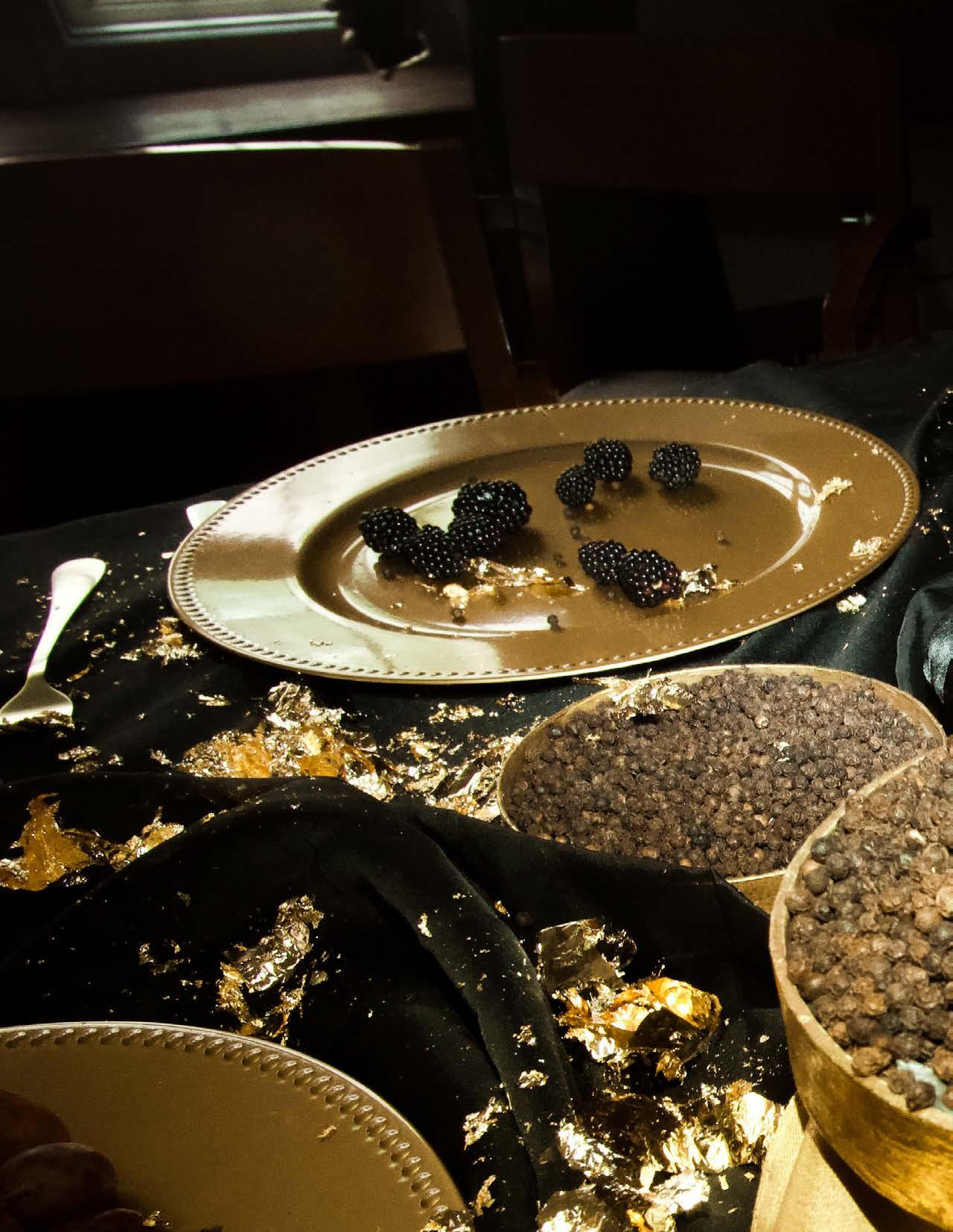

DIRECTION
Eloise Harcourt
Yabsera Bekele
Talia Zakalik
PHOTOGRAPHY
Ben Levine
STYLING
Kenna Freestone
Seo-Eun Kim
WRITING
Talia Zakalik
MODELING
Eloise Harcourt
Owen Rokous
Ethan McCormick
LAYOUT
Grace Demba


as the warm sunlight trickles into her bedroom, MaryRuth runs her fingers across her face. She examines every dimple, mole, divot, and unwanted indentation.
Then she begins the long and strenuous process of pouring oozing pale liquids onto her skin. She taps and taps, almost hitting herself to create the perfect allusion of sought after complexion.


Once there is no more redness in sight, Mary-Ruth draws pristine black lines around her eyes, highlighting their deep brown color that stands in contrast with her cinderella-like long blond locks. She parts her bangs to ensure that they maintain a perfect facial framing and scrunches the ends of her hair as she removes curling rolls that carry the scent of her silk sheets. Returning to her makeup, Mary-Ruth applies iridescent eyeshadow, one that glistens in her heart shaped beauty lamp.



As she finishes her final touches, a rosie blush with an equally perfect peach gloss to pair, she can not help but gaze at the serenity of femininity. The white lace bedding with pink detailing tempts her; it invites her to forget all her “womanly” duties that lay ahead. She turns to the walk-in closet, filled to the brim with blush luke hues, Mary-Ruth throws her nose into the dresses, inhaling the Coco Mademoiselle from the night before.

Her matching turquoise lingerie and baby doll stockings are slipped off and are slowly replaced by the only black in her closet. A leather dress with a black bustier makes its way onto her body. She is familiar with the tightening effect of the straps and welcomes the latex-like texture of the various accessories.
Reaching for a hand woven basket, she almost slips on her Lilly Pulitzer, a token from the other half of her life. Mary-Ruth fills the bag with whips, chains, handcuffs, and of course condoms (for safety that is). In keeping with her dainty love affair, she coats the cuffs in a flushed white fur, and decorates her goodie bag.

Finally,

“The doorbell rings as she bites her sticky bottom lip.”she unhooks the ribbon leashes by her door and prepares to meet her clients.


Once hands are shaken and words are exchanged, Mary-Ruth clicks her tongue and politely asks, “Boys, is there anyone in the mood for a vanilla sundae with whip cream and a cherry on top?!”
Without a second’s notice, they quickly assume the position of all fours as she leashes them, cuffs them, and makes her way to the ice cream parlor with her hungry boys trailing behind and dreaming of Cool Whip.

Creative Direction: Raghav Rastogi & Alyena Gilani
Photography: Fatou Kane, Ashna Ramiah, & Owen Rokous
Writing: Simmy Ghosh & Raghav Rastogi
Model: Simmy Ghosh

Styling: Raghav Rastogi
Makeup: Olivia Slemmer & Kenna Freestone
Layout: Sophie Floyd




Here I sit, waiting for you to take me. I see your pain. You wish to be free of the darkness that corrupts you. I offer you the escape. You take it.



I stain you as a mark. As a memory of your weakness. A physical reminder that you were not strong enough. Like oil in water, I separate from your frailty and instead embrace the fire that seems to burn within.




I am buried. You lie here with me.
Dirt and earth surround us as the ashes of our past mix with the potential of our future. Yes, we are once again in the darkness, but the light peaks through from the sky.







Here I stand. Here you stand. Here we stand. I am reborn. Bright, free, and new. I am in control. I am myself, I am free. Unburdened by my past. We are now one.

Johnnie has been waiting since homeroom to show Danny what he brought to school today.




“No! You eat it first.”
“No, I’ve already done it. It’s
“Last night, my brother gave me
“Okay. Fine. I’ll do it if you
“Whatever. Just take one of the
“Okay. Just one of them.”

“How is it?”
“Not…not too bad.”
“Right, just like I said.”
“You.. have to eat it now.”
“What? No. Are you okay?”
“NEver bettERr… your turn dudE!”
“Ookay okay. Whatever.”
“Are you crying?”
“NOt on PUrpose ugh.. Ach ugh.”
“You’re being dramATic, see I’m barely ….. Reacting”
“It’s pRetty Hot… doOn’t you thiiHInk??”
“I wouuULD say so pretty HOoot….”
“dO you have a . … TissuE?”
“I NEED. MILK”
“hhhhhhhhaA . hhhaA. mILk!”

“EVERYTHING OKAY OVER HERE BOYS?”
“Doing. GReaT. MR.s JOhsnon.”
“gggreeeAa TTtt.”
“KEEP IT DOWN.”


“need A carTON. SKihim Milk! pleasE.”
“OKAY. ONE TWENTY FIVE.”
“I doNOT hAve moneyyyy ahhhhasg#eee do you Have”
“noooOOO hhhhhhuuugug MOney”
“PLeeaASSE!!!!! MILK !!!!”
“gonnaA. Be sick. miLK”
“WHAT IS GOING ON WITH YOU TWO?”
“nothiNg! Nothing. At all.”
“totally fine. soO. Good.”
“GET OUT OF HERE THEN”
“hhhwWHAT do we doo????”
“My braaaaaain is meltiiiNGGG!”
“Try . Water”
“eauuuuuuaahhhHJJJJJJJJJJ”
“Sooo O much WORRSEEEE!”
“ARE YOU SURE YOU TWO ARE OKAY?”
“We’re. GReat!”
“DO I NEED TO SEND YOU TO THE NURSE? WHAT ARE THESE?”
“NOTHIng! Don’t Worry about”
“I’M WORRIED ALRIGHT”
“Its just like… A HOOOtooot pepper. Nothing. morE.”
“YOU ATE THESE? ARE YOU CRYING?”
“juST. A LItlle.”
“DRINK SOME MILK AND SIT DOWN”
“We’re going to have to steal it.”
“Agreed. (we steal the milk) (gulping it down).
“A ThousaANd bottles of Milk. COuld not fix this.”
“Its no. better. I think. I”m gonnA be SICK!”



DIRECTION: Alex Herzig
PHOTOGRAPHY: Ben Levine
WRITING: Lawton blanchard & Alex herzig
STYLING: Maxine roeder
MODELING: lawton blanchard
LAYOUT: RUBY GRANT

It is dawn. The clouds hang just above the horizon, their undersides brushed with streaks of orange, pink, and red. A burgeoning sunrise slowly reveals rocky hills patterned with shrubs. Amidst the sea of green and brown, there is a swatch of purple: a small gathering of crocus flowers with quivering, purple bulbs, a private, quiet beauty. A flower that would soon become one of the most coveted crops in history. As the sky brightens, delicate petals unfold, revealing their own red-gold suns within.
Such a scene might have occurred in the Maquis shrubland of modern-day Iran, perhaps Greece, in years before 700 BC. The stamens of the humble crocus in question would eventually become saf fron, the world’s most expensive spice by weight. The history of its cultivation is not entirely known: references to saffron appear in ancient texts such as the 7th-century Assyrian botanica, Chinese Pun Tsao Pharmacopeia, the Hebrew Tanakh, the Biblical Old Testament, ancient Greek myth, and more. This flower’s stamens have been coveted by some of history’s wealthiest and most influential figures, such as Alexander the Great, the Buddha Siddharta Gau tama, and Cleopatra. This flower was an integral part of the cultures and economies of countless Medit teranean, Middle Eastern, and West-Asian empires throughout history, being used for many purposes: medicinal, ornamental, ceremonial, and culinary.
I, admittedly, do not come from a saffron-infused culture. The spice’s bittersweet, earthy, and floral notes were absent from my parents’ blend of Cajun and Midwestern cuisines, even more so from that of my hometown in Oklahoma. My first exposure to saffron came not through its use as a spice, dye, or medicine, but rather through the crocus flower in a botany class freshman year.
As I prepare to graduate this spring, I’ve been re flecting on how my journey here began. Freshman year somehow feels like both a distant memory and just yesterday. Likewise, freshman year Lawton feels at times like a “purer” version of me – still doeeyed and bushy-tailed – unaware of what the next few years would bring. Other times, she feels like a complete stranger. Unlike most first-years, I didn’t think I had it all figured out. I didn’t have the cook ie-cutter plan to double major in X and Y, summer internship at Company Z, graduate in 4 years, and then land a job making 6 figures right after college (or maybe grad school first?). However, I saw this as a strength: I was free to experience and choose without a predetermined path. While the uncertainty
was daunting, I was still confident, perhaps overly so. It took a bit of boldness to move over 500 miles from home for college, even more so to demand to live and be respected as my true self without the support network or resources to do so.
Looking back, it’s easy to romanticize that period. I feel like I used to be so much cooler, more adventurous, more like the protagonist of my own story. Every experience felt so fresh and new. Every new piece of clothing or makeup was an opportunity to




But flowers aren’t meant to bloom forever.
Children eventually have to grow up, a key part of which is moving on. Clinging to that ideal of pure, youthful innocence only leads to disappointment and failure. A tree that doesn’t shed its leaves will die in the winter, and I contend that embracing this change only adds to its beauty. The past may seem “pure,” but it isn’t exactly “natural.” Just like the crocus, the past is something we cultivate. I think the only way to find peace in the present is to accept the past for exactly what it was, regardless of what it could’ve been. For me, that means accepting the upbringing I wanted isn’t the one I had, that my parents are just people, and the college experience I expected didn’t manifest. And that’s okay.

The saffron crocus does not occur naturally. It was engineered, through the selective breeding of a wild progenitor to produce the characteristically long, red-orange stigmas we know it for today. These stigmas, often referred to as “red gold,” are used as a cornerstone ingredient in Arabic, Iranian, Indian, Moroccan, and Central Asian cuisines and medicines. Yet each delicate crocus produces only three small stigmas that must be picked by hand, creating exorbitant labor costs.
Despite millennia of saffron production, the harvesting method has remained relatively unchanged. Saffron farmers must wait until fall begins – after the wine harvest and before the olive harvest – when temperatures drop and humidity decreases; otherwise, the stigma may wilt and mold. The farmers must awake early, arriving at the fields in the hours before the sun rises, before the crocus’ petals open, to protect the delicate stigmas from harsh sunlight. These three stigmas only produce 0.006 grams of dry saffron, yet each farmer hand picks up to 6kg of crocuses in the hours before the sun rises. The farmers deconstruct the flower: red stigmas go one way, yellow anthers another, purple petals in a pile of their own. This process lasts until around four p.m. when the farmers finally return home with fingers stained purple. The delicate nature of the flowers prevents the use of tools or mechanization –each step must be done by hand. In Iran, which produces 90% of the world’s saffron, around 80% of this labor is performed by women. For this 12-hour workday, these women are paid around 200,000 Rial, less than five US dollars.
The crocus is an engineered crop, a shining example of the human instinct to bend the natural world to our invented needs. The flower’s quiet, innocent beauty will always be dismantled. The exploitation of flower and farmer are intertwined: The saffron live to be picked and farmers must pick it to live. The labor is grueling and demanding, yet requires a great degree of care; brushing back coiled petals, tugging gently on red stigma – a tender sort of violence. The saffron flower may be doomed to be plucked, yet it can only offer its famed, earthy-sweet flavor through careful cultivation. In this macabre union, each member is taught a lesson. To a human, it is that hard work yields great rewards. For the flower, it is that pain is necessary for progress.
I’ve often felt that I’ve wasted my time at WashU, squandering my time and energy on extracurriculars and friendships that ultimately won’t serve me in the job market as much as a shiny 4.00 on the transcript. A kinder reading is that I spent so much time focusing on just surviving amidst rampant transphobia, anti-Blackness, and classism that there wasn’t much of me left for academics. A delicate flower in very rocky soil.
We’re taught that value is created through scarcity and reduction; taught to “trim the fat,” “kill your darlings,” or that true love is “one in a million.” Our lives and bodies, a pile of rubble with a grain of gold at the center. If you’re lucky, that is, and if you’re willing to dig for it. I spent so long waiting for someone else to pry at my depths, praying they’d find something within me that they found worthy of love, hoping then I could see it too. Isn’t that sad?
I wished I could separate the worst parts of me from the good, like the stamens from the crocus flower. My emotional volatility, distractability, procrastination... Pluck. Running so far from Oklahoma that the elders are forgetting my name while my younger cousins have never learned it. Pluck. The constant looming terror that in choosing to transition, to be happy, to be, well, me, I’ve chosen eternal damnation. Pluck. All discarded in a pile to the right, with the best parts of me left over: the dedication to run marathons, the emotion and artistry when I perform, the empathy and care I have for others.
However, you cannot have peaks without valleys. There is no growth without pain. Learning to love myself has meant realizing that pain and beauty are two sides of the same coin. It meant learning that the best parts of me were built and refined through the struggles of my traumas. It meant realizing that I am a thing of wonder, and not just a vessel for it. Like I said, flowers don’t bloom forever. It’s not their purpose. It’s their nature to be beautiful yet ephemeral, to bloom and wither. While cutting the flower is violent, could the act of preserving, displaying, or using a flower be a celebration of nature instead of a perversion?
Sometimes, I am the flower: a beautiful thing at the whims of nature. Other times, I am the farmer: using my own hands to manipulate and change the world around me. Life is the intimate, communal relationship between the two. The fire and storms are preparation for something greater yet to be seen. Through the struggle, I find my purpose.
Although these past few years have been difficult, I’ve learned to embrace that struggle as necessary to create the person I am and will grow to become, a struggle I chose.
I could’ve been like the flower in the field.
I could’ve stayed in Oklahoma, pleased my parents, grown into a good Christian man with a wife and kids in the suburbs. I could’ve found a way to be content, while filled with anger and wasted potential, refusing therapy for the fear of truly and deeply knowing myself. My crimson stains washed white as snow.



Red-gold. Saffron’s long-held moniker; a reference to its expensive price, but also to the incredible golden hues that its stigmas can produce. Dried stigmas are added to boiling water, producing a bloom of bright yellow pigment. A process that epitomizes the flower’s nature: an unassuming beauty that, when put to flame, reveals an even more vibrant beauty within – the golden reward of the farmer’s tireless labor, though the riches it garners are rarely seen by those who cultivate it. This stunning propensity to change earned saffron its lofty place in empires of old, adorning paintings, clothing, and even the hair and nails of history’s wealthiest.
Yet the future of saffron is uncertain, as its fields face a growing onslaught from climate change, causing decreasing yields and increasing costs. As demand for the flower grows, the market has been flooded with cheap imitations, decreasing the value further. These issues stack atop increased political and economic instability for the world’s largest producers, Kashmir and Iran. Each year, more farmers leave the fields to pursue a more stable future for their families in the city. The abundant seas of purple are slowly fading into the pale yellows of stabler crops such as wheat or barley – a far cry from purple, red, and gold. What saffron remains begins to wither in the increasingly arid deserts under an ever-harsher sun.
Without intervention, saffron may die out within our lifetime – not necessarily an extinction of the flower, but a cultural death. The golddyed silks replaced with printed polyester, the medicinal properties denigrated as old wives’ tales, the flavors and aromas forgotten by a people who’ve only ever known its imitations. The tragedy of the modern age, consumption without taste. After millennia of interdependence, the saffron will wither without fanfare and return to its natural place as a common wildflower.
But what if we dared to think differently? What if we rekindled our relationship with the natural world as one of communal care? If we humans are a part of and not apart from nature, what changes must we then take to bring our actions in line, to achieve harmony between flower and farmer?
If you laid down in the earth and told the crocus of its fate, do you think it’d respond with joy or despair? The saffron crocus is a mutant, unable to bear fruit and multiply without direct human intervention. To have survived for millennia, then, is its own miracle. Yet the saffron crocus has done more than survive: it has been cultivated, curated, and cared for. The flowers bloom for only a few weeks a year, and yet it’s left a golden stain across countless cultures over millennia. Our reverence of saffron might have been sustained by economic forces, but I cannot help but believe that it began from a place of love – for we knew gold was beautiful long before we knew it was rare.
A question I’ve long hated is “Where do you see yourself in five years?” For so long, I never expected to make it that long, and on multiple occasions, I tried not to. Yet, against all odds, I’ll turn 23 this summer. On the days it’s especially hard to imagine a future, I try to remember that I’m living beyond what were once my wildest dreams and expectations. To know that, despite my shortcomings, 18-year-old Lawton would be proud of the woman I am today. These are very uncertain times. But hope blooms in uncertainty. I look forward to turning 28, reflecting on this time, and laughing at how worked up I was over nothing.
When I came to college, I wanted to Do Big Things, and Make an Impact, and Change The World. Now I’m more pragmatic, and my purview has narrowed. Instead of fixing the whole world, I can focus on improving my little pocket of it whether that be at WashU, in St. Louis, or wherever the future leads me. Even the smallest pebble can create ripples in the ocean.
As a flower who has survived the journey from barren fields to become brilliant golden dye, I hope the mark I leave on the tapestry of time ensures a future for the next generation, even if that’s just to make the world a little less lonely for the next of flowers. But life is long and I still have a lot of it left to live -- in many ways, my cultivation has only just begun.










Sugar. Spice. And everything bridal.
Sugar. Spice. And everything bridal.
Maya Iskoz, Xavier Lucas-Cooper
Rayna Auerbach
Belal Hammad
Yasmin McLamb, Lauren MacBryde, Sophie Dorosin
Mackenzie Llewellyn
Grace Demba






Sugar. Spice. And everything bridal. For her capstone BFA collection, Mackenzie Llewellyn focuses on bridalwear. Why bridalwear? When I asked Mackenzie this question, she brought me to what inspired her collection in the first place: Victorian architecture. What does Victorian architecture share with bridalwear and marriage? They share “stable structures, exquisite details, and longevity.” Just like a Victorian home needs a solid foundation, a couple must build their relationship on a solid foundation as well. However, for both architecture and marriage, beauty is found in the small details. Hence, Mackenzie’s collection “Moments” focuses on these small details.
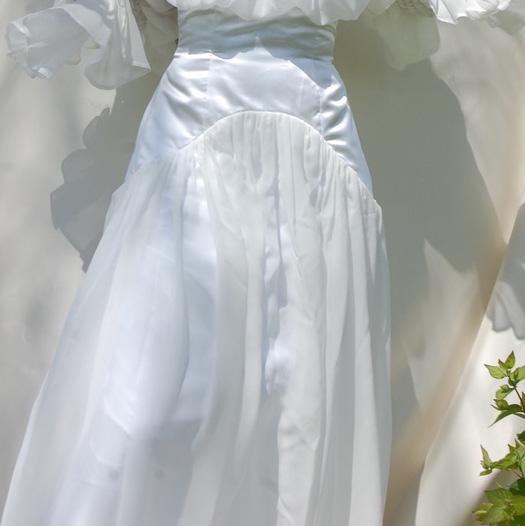






Houses, relationships, and their small details are all unique, and so are the weddings of different relationships. Yet, the bridalwear and Victorian homes share common themes that Mackenzie showcases in her work. Mackenzie’s bridalwear contains arched design lines and half-circle motifs, mimicking entryways and windows of Victorian homes. Mackenzie utilizes asymmetrical façades as well. Even Mackenzie’s techniques mimic the homes, such as smocking resembling the intricate woodwork of a Victorian roof.








Mackenzie also especially enjoys the sunburst motif in which lines extend off a central point, evident in pleats, circular yo-yos, and pintucks. Overall, Mackenzie believes in the sturdy foundations of marriage, yet the real meaning lies in the small details like the motifs and techniques.








Mackenzie loves bridal wear because in her opinion, it’s much more experimental. She has the opportunity to focus on all those small details, allowing her to create a tailored, unique, and beautiful bridal piece. Now for the big question: why bridalwear? Bridalwear allows Mackenzie to have a small part in someone’s special moment, something she finds inspiring. In making bridalwear, Mackenzie finds the opportunity to create, to experiment, and to go above and beyond, all while having a helping hand in a special moment and garment that will be cherished
forever. When I asked what fashion means to her, Mackenzie told me she loves that it’s always changing and that she enjoys the challenge of bringing things together visually, which is exactly what she does with her bridal collection. Relationships and weddings are unique and changing across different couples. In bridalwear, Mackenzie works with something unique every time, yet always has the opportunity to experiment with the different fiber manipulations in her work.
















At WashU, Mackenzie is in her last year studying Fashion Design and Entrepreneurship. She loves that WashU allows her to explore both fashion and business and also enjoys the campus and typical college experience. Above all else, Mackenzie loves the community here. She has her interests, inspirations, and collection, and having the support and community of her fellow students and professors made all the difference in the production of her capstone collection.
DIRECTION Grace Demba, Oli Zhang
PHOTOGRAPHY Emily Lapudis, Nina Bergman
WRITING Leena Bekhiet
STYLING Michael Yoon
MODELS Leena Bekhiet, Halima Larhdiri, Sabrina Elbouhali
LAYOUT Grace Demba

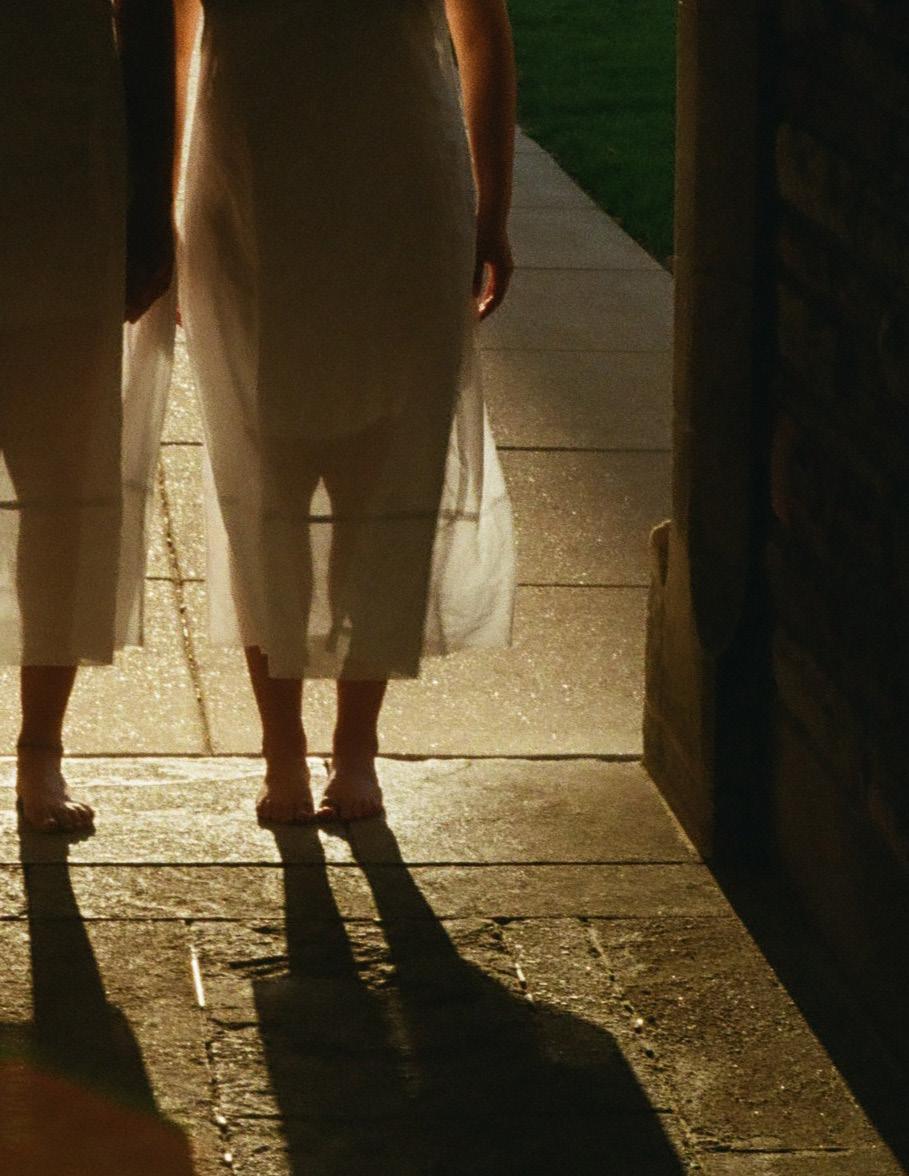

“Girls, the guests are here! Come quickly.” With their feet treading softly along the ground, they hurried to lend three sets of helping hands to their mother in the guest corridors. Everyone walked around barefoot in the house, even the guests—especially the guests. It was considered rude to keep outside shoes on; a sign of discomfort or hurriedness. When guests arrived, it was assumed they would stay for a while, taken care of in the comfort of the girls’ home. The girls were responsible for the guests’ comfort, offering chocolate sweets, baklava, mille-feuille, and of course, a warm cup of mint tea poured elegantly from their rarely-used fine china.

Every North African family grew mint in their garden. Amira clipped the mint leaves with kitchen scissors, making sure not to pull from the root as she snipped handfuls of the herb she would soon use as spice. Back inside, her sister Iman was waiting with the tea. “What took you so long?” Iman asked frantically. “The guests cannot have dessert without a hot cup of tea.”
“I’m sorry, you know how I love the smell of na3 na3. I spent a while sniffing the leaves as I plucked them,” Amira responded. After placing the mint into the teapot, Amira dropped a couple more leaves into each guest’s cup. The extra flavor could never hurt.
Amira held the drink tray, while Iman and Houda, the youngest sister, held sugar cubes, all in preparation for the offering they would make to the guests. “Bel na3 na3?’ (with mint?)”
Amira asked humbly. The guests replied eagerly, accepting the mint tea poured from the hands of Amira and her sisters. Within the minutes it took to prepare the cup and add in the sugar cubes, a conversation struck up between the guests and the sisters.
A voice complimented the strands falling neatly behind their ears, pin-straight. The girls’ hair was flattened with heat and freshly pressed. Amira thought to herself how she was no longer mankousha (frizzyhaired), the way she had been when she first washed her hair that morning. The guest, a middle-aged North African man, alongside his family, had no idea her hair took two hours to perfectly press, with the help of her two sisters— a flat iron in Iman’s hand and a hot comb in Houda’s. Amira had been inhaling the fumes of heat tools all morning, and she’d almost forgotten the smell of freshness.
The tea simmered. The liquid reached 180… now 190 degrees. Finally, it boiled. The liquid peaked at a sweltering heat of 212 degrees.
Her hair screamed for release from the compression. An oppressive heat of 400 degrees. Finally, her hair was pristine, pressed to perfection; its condition was mint.
“Merci, 3amo (sir),” Amira replied. Politely, she thanked him in French. Each day she inched closer and closer towards eurocentrism, and to the guest’s pleasure, eurocentric beauty. Hearing her own voice’s robotic response of appreciation, Amira became lightheaded—probably from the guest’s compliment that felt conditional. Conditional to her so-called cleanliness in tandem with the erasure of her Africanness. Her hair normally coiling up and bouncing playfully, today, lay flat and smelled of fire. Her hair mimicked ashes. Her culture simmered to a boil then died slowly.

“Go fetch the mint from the garden. Go make the tea. Go serve the guests,”Amira, spiraling in her own head, finally cried out, “Sisters, is this not absolutely crushing?”
“I am out of servitude. To naturally grow out of the ground and flourish, without a worry… oh mint how I envy you.” Quickly, Amira picked up the pot of tea. It had been sitting out for hours after the guests had left now.

She knew the feeling of the embossed metal teapot on her fingers, and she knew it well. She asked Houda, “please, will you join me in liberation? I despise this so-called purity.” Even the whiteness of her linen tunic embodied purity, whether she’d noticed it when getting dressed that morning or not.


“The tea is not so pure; it is contaminated by mint.” Take it and pour it onto me.” Amira cried out. Without question, Houda understood her sister’s request. So she prepared the teapot, this time without the same elegance as before. Submerged in cold tea, Amira understood her admiration of the flavorful herb better than before. Her hair transformed from its rigidness to its most beautiful curl, moisturized by the stain of mint. Finally, she was reborn.

“La2 shokran,” she replied to herself, “no thank you,” fiercely in her native tongue. “I do not want to pour tea any longer.” The girls all joined in. Their hair was liberated, falling against their teastained tunics, the linen lathered with freshness.
“Finally, I am free,” said Amira. “The smell of my mother’s cooking on my skin, the curly edges peeking through my scalp, the curvature of my nose, or of my body. I embrace all that I am.”
DIRECTION: David Win & Chandra Phenpimon
WRITING: Simmy Ghosh & David Win
S TYLING: Natalie Dinh & Michael Yoon

MODELING: Chandra Phenpimon, Sophie Lin, & Alivia Li
L AYOUT: Ruby Grant
PHOTOGRAPHY: Emily Lapidus & Ashna Ramiah MAKEUP: Olivia Slemmer

More than 12% of Thailand's total GDP comes from this industry, $4.3 billion are generated annually from sex work, and ten percent of all tourist dollars are spent on sex work. Sex work has been in Thailand since the 1300s, and it was first considered a taxable position that was acknowledged and supported by the government. Due to this policy, there was a large influx of Chinese immigrants to Thailand in the 1700’s. Japanese occupation in World War l popularized massage parlors, and US rest stops during the Vietnam War turned the country into a major tourist destination. Sex workers contributed largely to Thailands popularity in the Western world. When sex work was made illegal, the life and livelihood of hundreds of thousands of men and women lives were greatly affected.

Despite this fact, Tourism Minister Kobkarn Wattanavrangkul has completely neglected the role the sex industry has played in the building and sustaining of the Thai economy. By demonizing the sex industry, she has single-handedly placed a target on the backs of all sex workers and sufficiently ended the efforts of hardworking members of society trying to provide for their families. It’s easier to villanize women and condemn them for taking control of their own bodies, than it is to reconsider the way that most of us have been brought up thinking. We see it in movies, literature, and our day-to-day lives, in the form of small derogatory comments regarding women's sexuality. Despite the relative liberalness of Thailand, the issue of stigma still remains. The only way to end stigma is to


BEING A SEX WORKER ISN’T ABOUT A LACK OF CHOICE. IF I REALLY HAD NO CHOICE, I’D BE WORKING IN A GARMENT FACTORY.
Storytelling is both a Western conception for spreading awareness and a Thai method of weaving lessons for future generations; these stories aren’t simply for speaking of the dangers of sex work to a wider audience, but rather the tips of sex workers for sex workers. So, walk with us, not as simple specters. Walk in their shoes.
Lily Hermarratanarapong is a sex worker in Chiang Mai, Thailand. In the red light district, the neon lights dye the faces of these workers red, yellow, and green. Red becomes an imitation of blush. Yellow is historically a divine color for Thailand, and yellow skin an envy of Thai women. Perhaps it is the legacy left from their ancestors. Or it may serve as a reminder of the heavens long gone.
For the green overpowers the yellow. It becomes a silken cover of the wounds and exploitation these women’s bodies carry. The tapestries their bodies tell. Can you imagine? Like Las Vegas, a spectacle of vice. The excitement of the men soliciting sex workers can be visibly seen, their gaze undressing every woman. Unlike Sin City, the glamour is quickly dismantled. The women understand that these lights implore passion, but to them, they signal danger. Lily spoke on the dangers and harm that raids bring to the livelihood of sex workers. Raids are the strategy of choice for the Thai police in their attempt to curb sex work. While sex work according to legislation, is only able to be prosecuted if clients are caught in the act of soliciting, advertising, recruiting or engaging in commercial sex. Rules like this are put into place to “save” women who just do not require any assistance. Hermarrantarapong spoke on this, saying that "being a sex worker isn't about lack of choice. If I really had no choice, I'd be working in a garment factory."
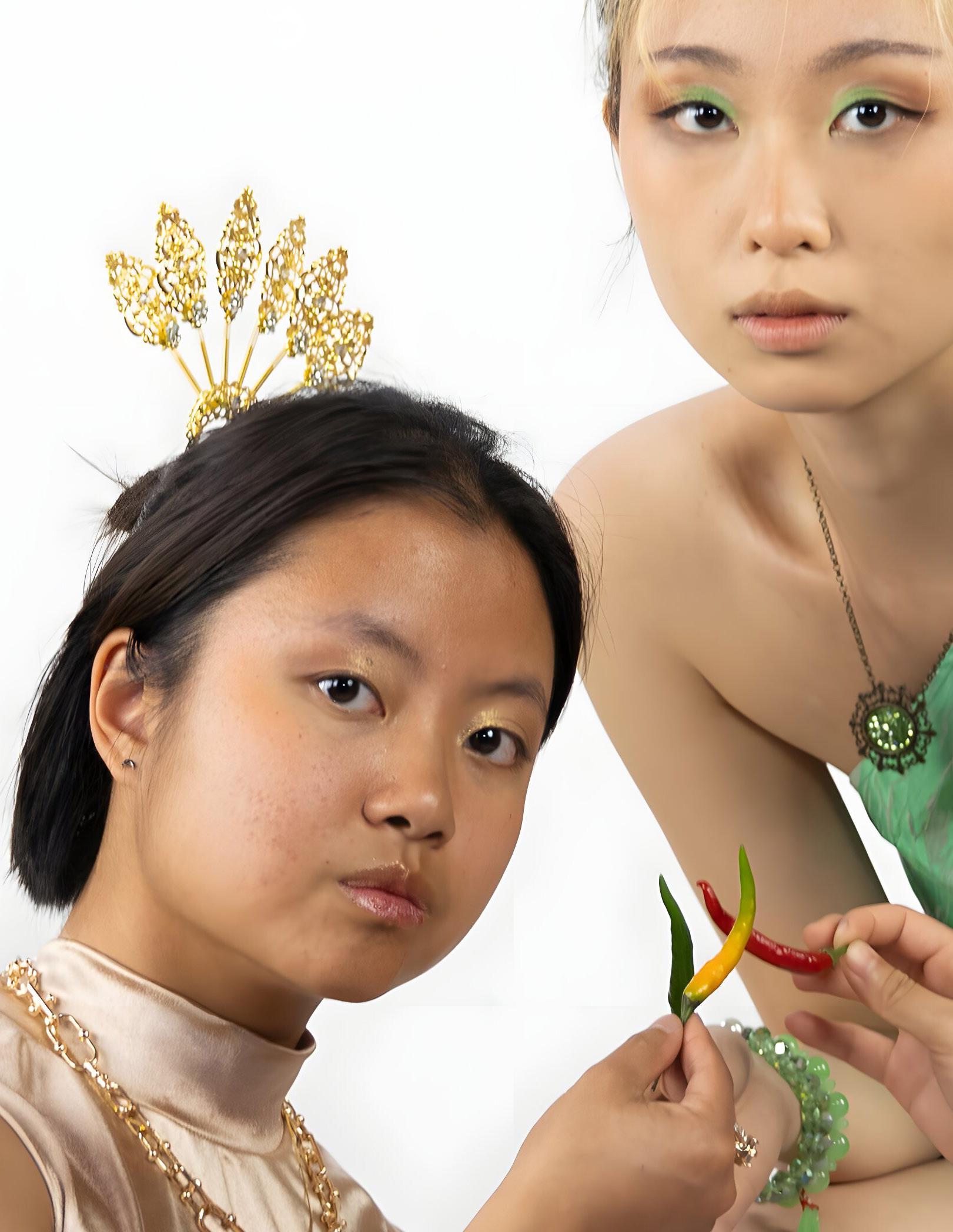



Garment work is a bleak reality for many natives in both Thailand and across Asia. Covid shined a brighter light on the severity of this issue with the “economic pain of the pandemic onto the most vulnerable people in supply chains (most of whom are women)”. Women in garment factories are overworked, underpaid, and put their lives on the line every day they go to work. A pertinent reminder that these women enter the workforce to become providers. So, the pricks of the needles that draw crimson blood are a testament to their resilience and to Thailand’s emphasis on family. The American dream in Thailand. The Thai dream. A grandma, mother, sister, and aunt must become saviors. An unfortunate circumstance that forces these women to become faceless. For they are the bodies of fast fashion.
Fast fashion is defined as “inexpensive clothing produced rapidly by mass-market retailers in response to the latest trends.” With fast fashion creating 52 “microseasons,” the only people who see some sort of satisfaction are those in the west who demand new trends every week. The freedom that sex work brings is a reprieve from this future and allows women the opportunity to take back their individual sovereignty.
With this in mind, legislation only creates more conflict. Police officers exploit sex workers and supplement their salaries through entrapment schemes. Sex workers, like Lily and the other women she worked with, are forced to give up parts of their salaries in order to pay the cops. The lack of legislation regarding sex work leaves women in dangerous conditions.

REPRIEVE FROM THIS FUTURE AND ALLOWS WOMEN THE OPPORTUNITY TO TAKE BACK THEIR INDIVIDUAL SOVEREIGNTY.
Another sex worker named Nueng spoke on the harms that this causes. Bars are able to enact intense and harmful rules on workers because their is not a party or power to counteract it or prosecute them for inhumane conditions. Neung speaks about rules such as a 110 weight limit for workers and a fine that needs to be paid if you “fall behind” on male clients. She also spoke on drink quotas that can reach up to 150 drinks per week, that sex workers must partcipate in, even if preganant. These tactics create severe problems for those like Lily and Nueng, who enter the field willingly and hope to make an honest living from their work. Both women are part of Empower, an organization dedicated to assisting sex workers in not only Thailand but also across the globe. Their headquarters in Thailand house a bar and nightclub, where women are able to work without the constricting rules of other bars. While western feminists preach on the sin of sex work and the assumed dangers that come from it, Empower works hand in hand with sex workers and values their truths instead of placing a western sensitized perspective on it.
The organization emphasizes not only the validity of sex work but also the importance of education. Their headquarters act as not only a drop in space for the thousands of sex workers in the city, but also as a library and a schoolhouse. The name Empower, actually stands for Education Means Protection of Women Engaged in Recreation. Empower has aided in helping thousands of women finish their Thai schooling, and houses more than 100 college graduates. Their decision whether or not to stay in sex work remains their own, and Hilton, an Empower employee put it best when she said “Empower isn't about changing sex workers. It's about sex workers changing society.” At Empower, they receive added benefits not found elsewhere like sick days and social security benefits. They are treated as human beings, which may seem like the bare minimum, but is a hard thing to achieve due to the absence of any employment regulation elsewhere regarding sex workers.

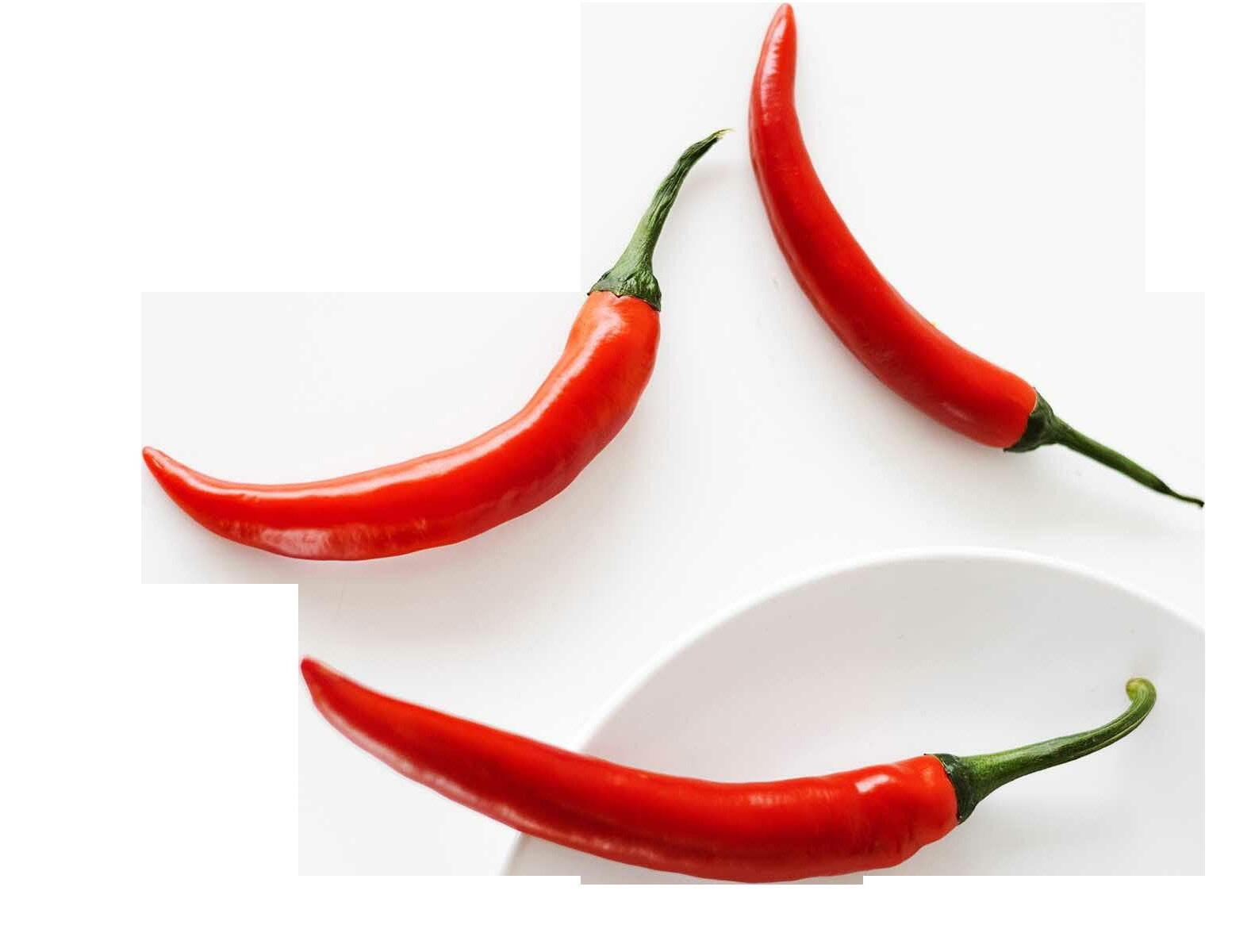
One of the most impactful things about the organization is how they leverage the narrative placed on sex workers by society, in order to enact real change. They own the label of “bad girls,” and instead redefine these women as changemakers saying “Bad girl: Any woman who behaves or thinks outside the space that society maps out for women.”
With sex work being the highly contested issue it is, it’s easy to look at it as an abstract concept and think of the act versus the women involved. These are highly motivated, intelligent women who are entering the field in search of a better life for not only them, but also their families. They choose to enter the field with an increased agency that is not found in most other career paths, but are left unprotected due to the nature of Thai law. With the decriminilization of sex work, Thailand will be able to support the 90% of individuals who enter the field willingly and prosecute and persecute the 10% who are being trafficked. With decriminilization comes more transparency, leaving space for productive legislation that can help these women, rather than punish them. This is a seemingly simple solution, but it is something that sex workers not only need, but most definitely deserve.
imacy of sex work. In an age where the world is increasingly more globalised, there is no excuse to not take a stand for change. So, here we stand, like the great storytellers, including Lilly, we must speak. In a country where exploitation is prevalent, sex work is an individual choice. It is a community choice--a group of women working together. This is feminism. As such, this can’t be said to be a passive decision. Sex work is a dagger and shield. What can be said to better represent this than the Thai Chilli Pepper.
EXTREMELY hot to deter predators, and their forms curved to conform to a point. As such, our stories center on three women, Thai Chilli Peppers in hand. A visualization of these womens’ power-- always theirs. The collaboration of red, yellow, and green mirror the Red Light District and the divine feminine of Mother Nature. For these women are everlasting in perseverance, power, and hope. They are bad girls. They are bad women. They are change makers. How about you?





